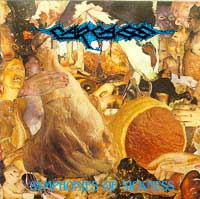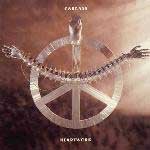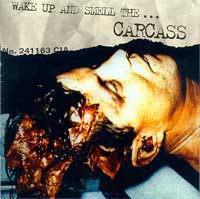Carcass
Original grind progenitors arising from the ashes of Napalm Death, Carcass initally recorded sloppy and gross material but have gradually progressed into technical and more oldstyle Iron Maiden rock-n-roll material.
Symphonies of Sickness/Reek of Putrefaction
Earache
|
1989
|
|
|
Production: Muted torsion of garage level production wrenches music through intense abrasion to create metallic effect of edging and polarizing musical tone.
Review: Melodramatic extremist grindcore explores the discontiguous nature of life's end in overdemonstrative but concise metapoetry involving simple, sloppy, grindcore riffs grating up against a metallic sense of extended arrangement and epic song construction. Despite the simplicity of the playing here, the players very skillfully manipulate simple melodies into the rhythm and handful of riffs and budget-composition elements to put together intense and wide-ranging songs.
Gutteral grunting and shrieking mockery are the two voices of guitarist and bassist as they work through mini-operettas of gastrointestinal fate, vivisection, or organ decomposition. Probing and tearing rhythms afflict cyclic winding into consistent motion which then decays, bubbling and chortling in guttural vocal accompaniment to detuned, suppurating guitars.
Tracklist:
Symphonies of Sickness
1. Reek of Putrefaction
2. Exhume to Consume
3. Excoriating Abdominal Emanation
4. Ruptured In Purulence
5. Empathological Necroticism
6. Embryonic Necropsy and Devourment
7. Swarming Vulgar Mass of Infected Virulency
8. Cadaveric Incubator of Endoparasites
9. Slash Dementia
10. Crepitating Bowel Erosion
Reek of Putrefaction
11. Genital Grinder
12. Regurgitation of Giblets
13. Maggot Colony
14. Pyosisified (Rotten To The Gore)
15. Vomited Anal Tract
16. Fermenting Innards
17. Excreted Alive
18. Suppuration
19. Foeticide
20. Feast On Dismembered Carnage
21. Splattered Cavities
22. Psychopathologist
23. Burnt To A Crisp
24. Pungent Excruciation
26. Oxidised Razor Masticator
22. Malignant Defecation
Length: 77:00
|

Copyright © 1989 Earache
|
The ability of this band to hang in rhythm despite it being a deliberately off-rhythm, distorted and muddied rhythmic requirement for playing each part qualifies their lengthier, grinding masterpieces which satirize older melodic styles in barre chords shuddering through a phrase. Varied are tempos, intelligently enough to pace songs against each other in settings from driving multiphrase blast beat to slow rolling double-hit death metal paces. Hardcore emerges as the face behind the genealogy in some running verses, bridge uptempo shifts, and deadpan industrial rock drumming.
This material, though built of barre chords and refragmented rock beats, has been assembled with the hand of composition to build material with life, violence, anti-ideological compassion, and humor. The tracks from "Symphonies of Sickness" are tighter and more modern where "Reek of Putrefaction" is raging eyesclosed thrust forward intense grindcore crossover. (Note: Earache has re-released these as separate albums with new updated and un-obscene cover art which seems to miss the spirit of these works.)
|
|
|
|
Production: Clear and ample, not quite enough of Jeff Walker's bass.
Review: Carcass started out life as a spinoff from England's Napalm Death, arguably the originators of grindcore: hard, simple, fast, off-time, loud, assaultive. Their first releases were barre chord masterpieces with a distinctive guttural, distorted voice belching out lyrics using grotesque medical terminology to describe impossibly fatal and disgusting bodily quandaries. The Reek of Putrefaction/Symphonies of Sickness LP defined Carcass as the premiere grindcore band in the world while most other bands in the genre disintegrated.
Necroticism - Descanting the Insalubrious showed the band applying instrumental learning to craft more modern grindcore: tighter, abrasive rock-like harmonies and blasting rigid grindcore percussive structures, drawn more in the cutting edges of chords played off each other in compact structures than loose, heavy sludgeblasts colliding in the freespace of off-time drumming. Heartwork extends this progression further, but also drops Carcass back to the stone age of their influences as young musicians
Guitar-flash commercial hard rock, a sound Carcass had so seriously eschewed during their early days one wonders about the conception behind this album, has taken over direction and technique to make noodle-heavy rock that maintains fervor in its technical speed metal riffing. On Heartwork, all objections and preconceptions aside, this band pull off their new style well, but even well in this style is not as distinctive as their original works. The ornamentations of heavy metal accompany a distorted Carcass-style rasp and the muscular sense of rhythm in riffing from the last album, creating one of the most unusual crossovers ever to hit vinyl. Songs are faster, reminiscent of something as tame as later Megadeth, with more emphasis on the guitar solo (something generally played in noise rather than notes in early Carcass) generating extensive lead playing, interludes, dual-guitar (yes, a la Iron Maiden) harmonic meandering and a general resemblance to normal rock.
Tracklist:
1. Buried Dreams
2. Carnal Forge
3. No Love Lost
4. Heartwork
5. Embodiment
6. This Mortal Coil
7. Arbeit Macht Fleisch
8. Blind Bleeding the Blind
9. Doctrinal Expletives
10. Death Certificate
Length: 41:57
|

Copyright © 1994 Earache
|
Many have noted the similarity of melodis on this to later Kreator, and from that comparison similar ingredients can be found. The precision rhythm riffing of speed metal matches up to Led Zeppelin style "advanced" rock structures, and the shrieking distorted growl of grindcore falls into baladlike melodies which introduce complex rock guitar in a cliche style that heavy metal bands once exploited. The raw passion and demented humor of previous albums has been replaced by a controlled professionalism that recognizes socially accepted form over function or content.The vocals have lost their crepitative quality, a sagging heaviness of eructation and enunciation that made veritable the lyrics: incarnations of decay.
This disc is far from unlistenable, unlike the speed metal bands it follows, because it does not become thoroughly insipid or so thoroughly adulterated with commercialism as to reek of bad glam metal played quickly: it creates its own space among listeners and moves into it. Its motivations while not as urgent nor as insistent as those of earlier years are still viable, and it fits well within the genre, but reeks of lost ambition and missing potential. The conversion of grindcore to its origins in accepted commercial rock did not sit well with the fanbase, and this album essentially slammed shut the career of this promising band.
Drumming is the same precise, varied, tempo-shifting fluidity that Carcass used on their last album; there is substantial double-bass drum playing, a lot of quick-footed tempo dives and ascensions, and occasional moments of peculiar intricacy. The two guitars integrate smoothly, following each other for main riffs and then taking turns to drift into quick, melodic, and expert solos, and then dropping as quickly to masticate another riff. The less intense vocals that allow this to be sold on Columbia/Earache without American audiences flipping out, despite matching the music with emphasis and tone, compete poorly with guitar for contributions to song narration.
Bass guitar, although proficient, shows no sign of distinguishing itself from the norm, in similarity to the other instruments on this album. While it is demonstrated these gentlemen can play, they are playing commercial rock, and do not seem to be finding inspiration in what they do. Consequently, this album will forever be introduced with mixed feelings: sad Carcass have gone for the maximum money monster, but impressed by the competence and study of the genre they have undertaken.
|
Wake Up and Smell the Carcass
Earache
|
1996
|
|
|
Production: This definitive pronouncement of the band's death samples from six sessions throughout their career, newest first with a clear digital sound to oldest with a crepitant AM ambience.
Review: Carcass founded much of what grindcore would become by managing complexity and compositional coherence through simple riffs without compromising the extremity of their art; the subtle difference lurked almost entirely in the distinctiveness of their riffs and songs because of their compositional centering in melody. This posthumous compilation of rarities stretches an impression of their career across an album worth of material.
The first session here features alternates from "Swansong," which is beautiful neo-classical metal that rolls along through rock rhythms and melodic riff hooks but leaves the stark austerity of death metal behind and often gets bogged into the predictable elements of rock. Thus these are beautiful works for their application of form within constraints, but more craftsmanship than inventor art.
Second comes recordings from the BBC Radio One show, with full sound and all of the distortion that one would expect and enjoy from a live radio recording. These songs originate in the album Heartwork which began the Carcass progression toward older metal styles but retained some of the poise and counterelement construction of the "Tools of the Trade"-era material; well- and sometimes appreciably more savagely-executed, these songs rock and rip. Notably the cover of "No Love Lost" features a custom introduction in the form of a regurgitated "Exhume to Consume" from two albums earlier.
Tracklist:
Unreleased Tracks from "Swansong" sessions 1995
1. Edge of Darkness
2. Emotional Flatline
3. Ever Increasing Circles
4. Blood Spattered Banner
5. I Told You So (Corporate Rock Really Does Suck)
Radio 1 Rock Show sessions 1994
6. Buried Dreams
7. No Love Lost
8. Rot 'N' Roll
9. Edge of Darkness
Heartwork EP sessions 1993
10. This Is Your Life
11. Rot 'N' Roll
Tools of the Trade EP 1991
12. Tools of the Trade
13. Pyosisified (Still Rotten To the Gore)
14. Hepatic Tissue Fermentation II
Pathological compilation 1989
15. Genital Grinder II
16. Hepatic Tissue Fermentation
Grindcrusher compilation 1989
17. Exhume to Consume
|

Copyright © 1996 Earache
|
The next two sessions are EPs from the former life of the band, the first being the two extra Heartwork songs released on the EP by the same name, and the second reaching slightly farther back into band history to grab songs from the Tools of the Trade EP which came out after their third album, emblematic of the band in its abundance after the "event" of the album. This material is enjoyable although caught between the evolving technicality of the band and their more abrasive, rigid, and contramotional moments from the "Necroticism - Descanting the Insalubrious" album from which these inspirations came.
The two remaining sessions are both tracks recorded for compilation CDs, beginning with the Pathological compilation which received brutally-distorted yet upbeat versions of songs from "Symphonies of Sickness," the groundbreaking 1989 Carcass masterpiece, including a perhaps more melodic bass presence. The second compilation, Grindcrusher, bore an amazing version of "Exhume to Consume" complete with neo-noise, neo-ultragrind introductory material and booming violently distorted production.
Start to finish this compilation is an impressive collection of work by an impressive band, and as such like the life of the band is prone to controvery, as styles and intensity of the music vary throughout its tracklist. Evident is the futility of competition by recent Carcass material for metalhead appreciation when up against the very tracks that defined the style rennovating grindcore from random rhythmic violence into coordinated, strict, and virulent pieces of evocative, communicative music. In this disorienting placement the granularity of this album keeps the tension of an innovative musical career at the forefront of the memory of a classic band.
|
BLACK | DEATH | HEAVY | SPEED | THRASH | GRINDCORE
Copyright © 1988-2004 the Dark Legions Archive
|


